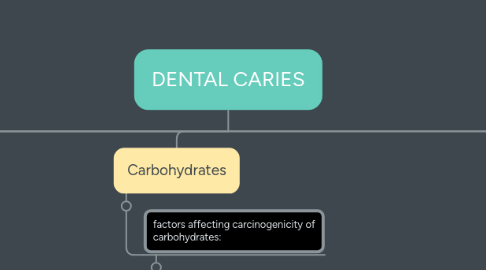
1. DEFINITION
1.1. A localized microbial disease affecting post eruptive hard tooth structures characterized by demineralization of the inorganic portion and destruction of the organic substance of the tooth.
2. Types of dental caries
2.1. 1- Pit and fissure caries
2.1.1. the most common
2.2. 2- smooth surface caries
2.3. 3- Root cavity
2.4. 4- Recurrent caries
2.4.1. 5- Acute rampant and chronic caries
3. Factors affecting caries production
3.1. 1-Host factors
3.1.1. A-Susceptible tooth
3.1.1.1. B-Saliva
3.2. 2-Carbohydrates
3.3. 3-Cariogenic microorganisms
3.4. 4-Time
4. Host factors
4.1. A-Susceptible tooth
4.1.1. depending on:
4.1.1.1. 1- position
4.1.1.1.1. 2-morphology
4.2. B- Saliva
4.2.1. 1- washing efect
4.2.1.1. 2- salivary glycoproteins
4.2.1.1.1. 3-buffering capacity
5. Carbohydrates
5.1. factors affecting carcinogenicity of carbohydrates:
5.1.1. 1- types of carbohydrates
5.1.1.1. 2-total amount of intake
5.1.1.1.1. 3- frequency of intake
6. cariogenic microorganisms
6.1. the characteristic of cariogenic bacteria:
6.1.1. 1- Acidogenic
6.1.1.1. 2- Aciduric
6.1.1.1.1. 3- synthesis of extracellular polysacharides
7. Dental plaque
7.1. is a tenacious adherent biofilm
7.1.1. composition:
7.1.1.1. 1- microorganisms (60-70%)
7.1.1.1.1. 2- an amorphous matrix(30-40%)
7.1.2. factors affecting plaque formation:
7.1.2.1. 1- anatomy & position of tooth
7.1.2.1.1. 2- presence of appliances
8. Pathology of dental caries
8.1. A-Enamel caries
8.1.1. enamel caries develops in four main phases:
8.1.1.1. 1- phase of initiation
8.1.1.1.1. 2- phase of bacterial invasion
8.2. B-Dentin caries
8.2.1. the dentinal lesion involve:
8.2.1.1. 1- uninfected lesion (deepest and most close to pulp) ➡ Acid Attack
8.2.1.1.1. 2- infected lesion (bulk of the lesion)➡ Bacterial Invasion
